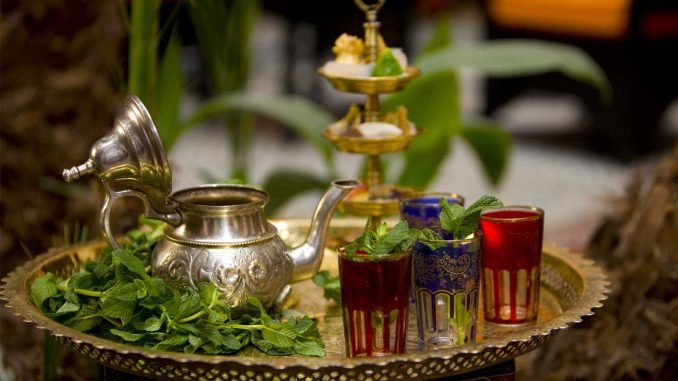Moroccan mint tea, made from green tea, is a real tradition in this country. It’s served by lifting a beautiful teapot high above the ground, and is a favorite with tourists too. To feel like you’re in an oasis in the middle of the desert, discover the traditional recipe for Moroccan mint tea.
THE ORIGINS OF MOROCCAN MINT TEA

Mint tea, also known as “nanah” tea, is an emblematic beverage of Moroccan culture. This fragrant infusion, combining the freshness of mint with the strength of green tea, is a veritable social tradition in the Maghreb.
Its origins go back several centuries. Tea itself originated in China, where it has been cultivated and consumed since antiquity. During trade voyages between the Far East and the Maghreb, green tea arrived in Morocco, probably from the 9th century onwards. Mint, meanwhile, was already widely cultivated in the region.
It was in the 18th century that the mint tea tradition really took root in Morocco. It quickly became a symbol of Moroccan hospitality and conviviality. Even today, sharing a mint tea is a gesture of welcome and generosity, offered to visitors as soon as they arrive in a Moroccan home.
BENEFITS AND SIDE EFFECTS OF MINT TEA

Moroccan mint tea offers a unique taste experience, but it’s also appreciated for its health benefits. Here are some of the benefits associated with its consumption:
Improved digestion: Mint has antispasmodic properties that can help relieve digestive problems such as bloating and abdominal pain.
Stimulating effect: Green tea contains natural caffeine, which can help boost energy and alertness.
Antioxidants: Green tea is rich in antioxidants, which play a role in protecting cells against oxidative damage.
Soothing properties : Mint has soothing properties and can contribute to relaxation and stress reduction.
However, there are a number of side effects and contraindications to consider. At high doses, intestinal disorders, headaches, hypertension and reduced iron absorption are possible. In addition, people who are sensitive to theine may experience side effects. Consumption of mint green tea is therefore not recommended for pregnant women, iron-deficient people or those with haemophilia.
THE TRADITIONAL NANAH TEA RECIPE

Moroccan mint tea is served according to a traditional ceremony. A richly ornamented tray carries the metal teapot (berrad) for infusing the blend of green tea and mint. Small tulip-shaped glasses (verr’âs) allow this convivial beverage to be enjoyed in batches.
Its preparation is a ritual handed down from generation to generation. Discover the traditional recipe below.
Ingredients :
- 4 teaspoons loose green tea
- A handful of fresh mint leaves (preferably nanah or spearmint, if possible)
- 1 liter water
- Sugar (to taste)
Instructions :
Step 1:
Heat the water in a kettle until it almost boils.
Step 2:
In a metal teapot, put the loose green tea and add a little hot water to moisten the tea.
Step 3:
Gently stir the tea to distribute the water and let it stand for a minute or so, then pour the remaining water into the teapot.
Step 4:
Add the fresh mint leaves to the teapot.
Step 5:
Add the sugar according to your preference (Moroccans generally enjoy it quite sweet).
Step 6:
Place the teapot on a low heat and let the tea infuse for a few minutes, without boiling.
Step 7:
Pour the mint tea into small glasses, holding the teapot high to create froth (froth is a sign of quality in mint tea preparation).
Which mint to use?

To prepare a delicious mint tea, it’s best to use spearmint or Moroccan “nanah” mint (Mentha spicata), also known as “sweet mint”. This mild, refreshing mint is favored for its subtle, pleasant taste, which blends perfectly with green tea.
You can also explore variations on mint tea:
Peppermint (Mentha x piperita) offers a more intense, spicy flavor, ideal for those who prefer a spicier note in their tea.
Glacial mint (Mentha x piperita glacialis) can bring an extra freshness to your tea, ideal for summer days.
Chocolate mint (Mentha x piperita chocolate) will add a gourmet touch to your tea with its subtle chocolate notes.
Mint essential oil can also be used to add an intense aroma. But be careful: it’s highly concentrated, so only a few drops are needed!
In all cases, fresh mint leaves are preferable to dried ones: their naturally pronounced aroma lends authenticity to this traditional Moroccan beverage.









